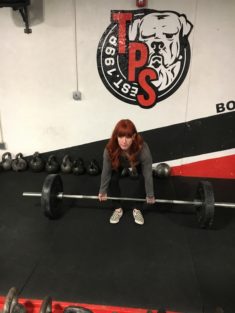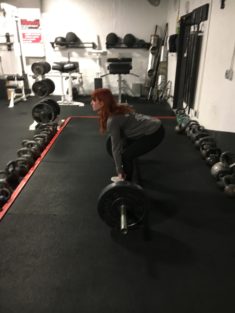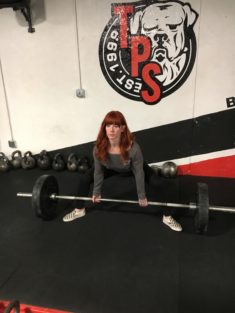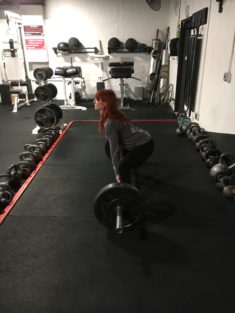Written by: Kevin Cann
The conventional deadlift versus the sumo deadlift is one of the great debates in the strength sports.
Many will argue that the sumo deadlift is “cheating” because it has a shorter range of motion (ROM). People will also argue that the sumo deadlift is easier because it allows your hips to stay closer to the bar.
However, is this really the case? Is the sumo deadlift an easier version of the deadlift? Research has actually looked into this subject.
Before we get into that, we need to have an understanding of the physics behind the deadlift. This applies to both the sumo version and the conventional deadlift.
They are total body lifts that place demands on our back, hips, knees, and ankles. Depending on how we choose to setup, some of these change.
Front and side view of the conventional deadlift


Front and side view of the sumo deadlift


One major difference between the sumo deadlift and the conventional deadlift is on the demands that they place on our spinal extensors.
The greater lean that we have of the torso; the greater the spinal flexor moment arm, making it more difficult for us to remain in an extended/neutral position. The conventional deadlift requires a 5% to 10% greater lean of the torso than the sumo deadlift. This makes the conventional deadlift tougher on our back muscles, especially our spinal erectors.
We are going to skip the hips for now and come back to them later on.
In the conventional deadlift our shins are pretty vertical. At most we may have 10 degrees or so of dorsiflexion at the start. This is extremely small and the quads are probable fighting the hamstring co-contraction more than the weight of the bar to extend the knees. Unlike the squat, quad strength is most likely not a limiting factor in the conventional deadlift.
However, the sumo deadlift places different demands on the knee extensors. The sumo deadlift setup is going to have significantly more knee flexion. This places a greater demand on the quads.
The sumo deadlift is basically a high squat. The greatest quad demands in the squat are coming up out of the hole. Since the sumo deadlift begins higher than the sticking point for the squat, the demands on the quads will be less than the squat, but greater than the conventional deadlift.
Now let us look at hip extension demands in each lift. Research has shown that the hip extension demands for the sumo deadlift and the conventional deadlift are the same.
You may be thinking “how can this be if the hips are closer to the bar in the sumo deadlift?” To answer this question we must first understand the definition of a moment arm.
A moment arm is the length between a joint axis and the line of force acting upon the joint. The moment arm for the hip extensors in both deadlift variations is the femur. Femur length does not change. No matter where you place your feet, femur length remains a constant.
The distance you lose in the saggital plane (plane of motion that cuts the body into left and right), you pick up in the frontal plane (plane of motion that cuts the body in half from back to front). In either variation the further your hips get behind the bar, the more difficult it is for your hip extensors.
With that said, the conventional deadlift does require approximately 25% to 40% more mechanical work than the sumo deadlift. This is due to the greater distance the bar needs to travel. With the feet wider and the hands typically closer, the bar travels less of a distance for the sumo deadlift than it will for the conventional deadlift.
Does this make it easier though?
I do not think it is as simple as lifting the bar less distance makes it easier. The sumo deadlifts are going to be more difficult off of the ground and the conventional pull will be most difficult around the bottom of the knees.
People miss lifts because they are not strong enough through these weak points. If you have weak spinal erectors, then the sumo deadlift will feel easier than the conventional deadlift because it hides these weaknesses by allowing you to have a more vertical torso.
On the other hand, if you have a weak squat and can’t break the bar off of the floor in a sumo position, chances are you have weak quads and the conventional pull will be easier for you, even though it requires 25% to 40% more mechanical work. If you participate in Crossfit, the mechanical work piece may be important since it will make higher rep sets easier to complete and for a faster time.
Hip anatomy and mobility will also play a role.
Ultimately you need to find which variation works best for you. The one that works best now may not be the one that works best later on down the road. Find a good coach and learn how to use both variations. I actually like the sumo deadlift as a squat builder. It helps build the quad and upper back strength required in the bottom of the squat.
Mess around with both variations and see which one works best for you. This should be done over a few months to give each one a fair amount of time to train. Make sure you have a good coach watch you, because techniques in both are very important.
You may do better in the sumo deadlift, but it is a very technical lift. You do not want to miss out on big strength gains because you are performing it incorrectly. The hip extension demands are the same, the conventional deadlift requires more back strength, and the sumo deadlift requires more quad strength.
Understanding those differences can help you pick which one may be best for you. If you have had back issues in the past, stick with a sumo pull, as it places less shear force on the spine due to the more upright torso.
References:

I might have to experiment with the sumo during my next workouts … great post!
Biomechanically speaking. Why do you train you body to pull a load that is not in a natural position. You don’t walk, run or jump in a sumo position. So why would we train our body to do so.
No, but you do pick things off the floor in a wider stance in everyday life situations, particularly if the object is large and you need to place your feet around the object. Furthermore, if you can’t maintain a neutral spine while going to the ground in a conventional stance deadlift, forcing that stance (and compromising spinal stability) is much more harmful than spreading the feet out and performing a full form sumo deadlift to the ground with a neutral back position. Additionally, think about little kids playing in sandboxes; a lot of them naturally squat in a wide sumo stance. I don’t think many of us would attribute that to the kid being devolved and weakened by 21st century living of too much couch and/or desk time sitting. That’s just what kids naturally do because the wider base is more stable for them.
I dont think I have ever seen kids playing in sandboxes with a wide sumo stance squat, they would sometimes squat in a WL squat however
Spreading the legs wider requires more frontal plane knee stability. This is important for change of direction in sport. How is the sumo stance not a natural position? Have you ever straddled an object, bent down, and picked it up?
I actually just picked up some very large and heavy ceramic pots yesterday in a sumo deadlift position. For large unwieldy objects, it’s one of the natural positions to go to.
Ha, so the bodybuilder at my gym doesn’t know what he’s talking about when my deadlift is more than his but he says it’s actually less because sumo makes it easier. Fricken workout warriors man.
I went to crossfit and learnt functional movements. I now do one set 5 times a week with my own weights.
The trainer tried, and tried and tried to get me to “get” conventional deadlifts. I couldn’t do it safely. But sumo was ingrained in my brain. Perfectly every time. After a lot of trying he said – “ok, ok, ok – any wods we do going forward your not to do conventional. Tell the trainer I said your to substitute with sumo”
I wish I could do conventional and no way am I risking a damaged back to try. I lift to be healthy and not for competition, so horses for courses.
Good read – thanks!